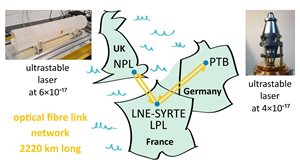3 minute read
Using cutting-edge optical frequency standards developed at PTB and NPL, the team has been able to demonstrate that their measurement precision is preserved even when transmitted across thousands of kilometers of optical fibre.
This metrological optical fibre network has been specifically set up for comparing a new generation of atomic clocks, referred as optical atomic clocks, as they operate at optical frequencies. This new generation is demonstrating a measurement precision orders of magnitude higher than the previous generation operating in the microwave domain. The extreme precision of optical atomic clocks will enable new applications, such as measuring gravity through its associated temporal distortion - an effect described by Einstein’s theory of general relativity. The optical standards used in this work are very important because their higher precision in the synthesis and measurement of time and frequency leads to immediate benefits to critical infrastructures of our modern technological society, positively impacting for instance on communication, synchronisation, localisation and navigation systems. We all rely on these critical systems in our everyday life, their performance affects our quality of life and sets the pace of the technological and economic growth of our society.
 The metrological optical fibre network utilised in the measurements is operated by multiple research institutes, as a result this activity has been highly collaborative and international, involving 32 authors from five institutions, namely: NPL in the UK, RENATER, LPL and LNE-SYRTE in France and PTB in Germany.
The metrological optical fibre network utilised in the measurements is operated by multiple research institutes, as a result this activity has been highly collaborative and international, involving 32 authors from five institutions, namely: NPL in the UK, RENATER, LPL and LNE-SYRTE in France and PTB in Germany.
Just like quartz oscillators are key components in conventional microwave clocks, ultrastable lasers play a critical role in optical clocks. State-of-the art ultrastable lasers like the ones used in this study achieve a stability better than 6 parts in 100,000,000,000,000,000. For instance, fractionally this is equivalent to a wobble of the distance between the Earth and the Sun of less than the width of a hair. Such precision is realised using optical reference cavities providing an optical standing wave with a frequency stability set by the distance of the mirrors. The stability of the optical references demonstrated in this work corresponds to an average variation of the position of the mirrors 50 times smaller than the diameter of a proton, over a cavity length of about half a metre.
Being able to transfer such precision to distant locations not only proves once again that optical fibre networks can be used to compare optical atomic clocks, it also enables more widespread, efficient utilisation of the cutting-edge research infrastructure otherwise only available at a few national laboratories. In this work we discuss how this measurement precision can be made available through optical fibre to a much larger community of users, ranging from other national laboratories, academia and industry.
This work is available here

Marco Schioppo, Senior Research Scientist, NPL states: “This work is important as it demonstrates that it is possible to compare two geographically distant ultrastable lasers and measure their fundamental noise using an optical fibre network. We show that ultrastable lasers can be used to effectively measure the total fibre link noise. We also assess the possibility to disseminate ultrastable light to distant users through optical fibre. Our work is an important step towards making available the time and frequency high-precision measurement capability of a national metrological institute to a wide range of users.”

Jochen Kronjäger, Senior Research Scientist, NPL states: “I find it absolutely fascinating to see how two world-leading ultrastable lasers, developed independently and both pushing the boundaries of optical technology, can be compared to reveal their fundamental noise, despite being separated geographically by almost 800 km. It’s a phantastic demonstration of the power of light, made possible by many years of international collaboration.”
Hear directly from Marco Schioppo about this work
Find out more about NPL’s work on Time and Frequency
11 Jan 2022